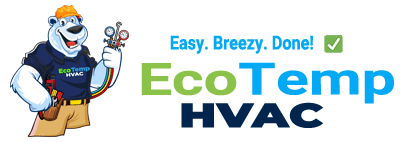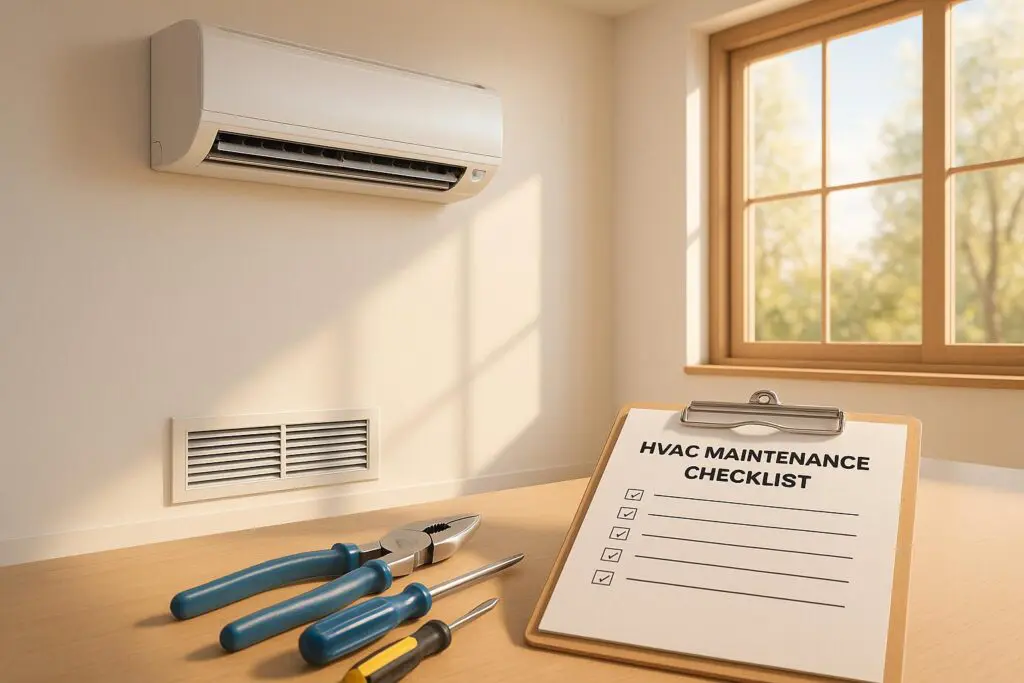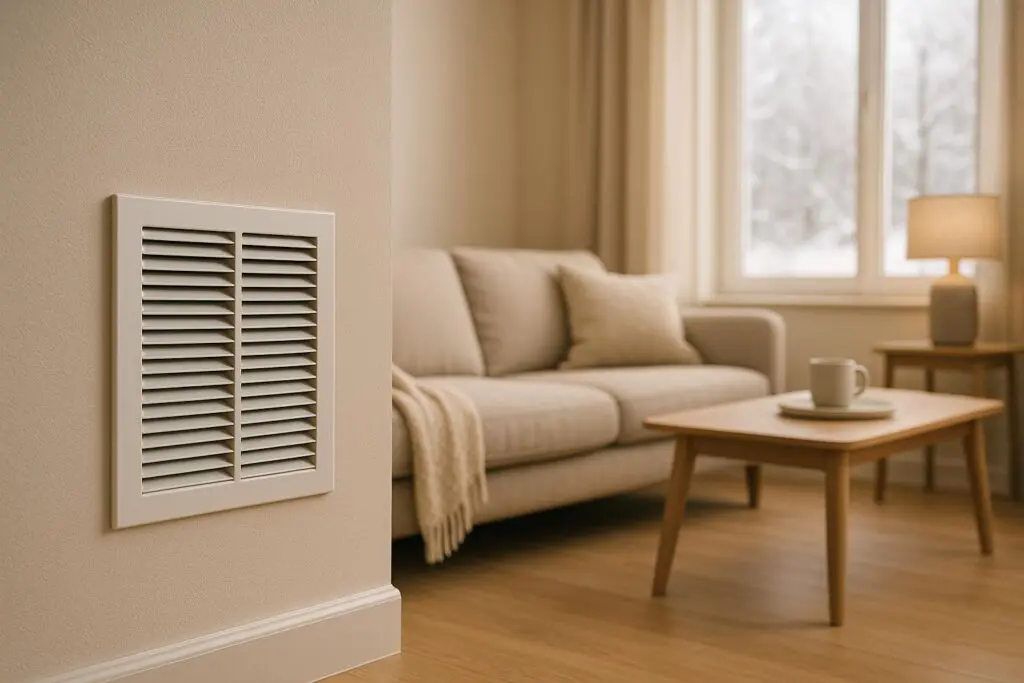When your air conditioner runs but doesn’t cool your home, the problem is often easier to fix than you think. Start by checking these common issues:
- Thermostat Settings: Ensure it’s set to “Cool,” the temperature is lower than the room temperature, and the fan is on “Auto.” Replace weak batteries or relocate the thermostat if it’s near heat sources.
- Dirty Filters: Clogged air filters restrict airflow, causing inefficient cooling. Replace or clean filters every 1–3 months during heavy use.
- Blocked Vents: Ensure all supply vents are open and unobstructed by furniture or curtains to maintain steady airflow.
- Refrigerant Issues: Warm air from vents may indicate a refrigerant leak or low levels, requiring professional repair.
- Dirty or Frozen Coils: Debris on the outdoor unit or frozen indoor evaporator coils can hinder cooling. Clean the outdoor unit and let frozen coils thaw completely before restarting.
If these steps don’t resolve the problem, it’s time to call an HVAC technician. Regular maintenance can also prevent many of these issues, keeping your AC efficient and your home comfortable.
AC Unit Not Cooling House – 20 Reasons Why
1. Thermostat Settings and Problems
The thermostat is the brain of your AC system, and even minor issues with its settings or functionality can disrupt cooling. Before jumping to conclusions about a major air conditioner failure, take a moment to inspect the thermostat – it’s often the root of the problem.
1.1. Check Your Thermostat Settings
A common oversight is setting the thermostat to "Fan" or "On" instead of "Cool." In "Fan" mode, the system only circulates air without cooling it. Double-check that the thermostat is set to "Cool" and adjust the target temperature to 3–5°F below the current room temperature. Accidentally setting it to "Heat" will, of course, blow warm air – definitely not what you want on a sweltering day.
Switch the fan setting to "Auto" to ensure it only runs when the system is actively cooling. This avoids the constant movement of uncooled air.
Other quick fixes include replacing weak batteries and ensuring the thermostat isn’t placed near heat sources like windows, lamps, or appliances. These can cause the thermostat to read an artificially high temperature, leading to uneven cooling. If these simple adjustments resolve the issue, your thermostat is likely functioning as it should. If not, the problem may lie deeper, such as faulty wiring or sensor errors, which we’ll cover next.
1.2. Faulty Thermostat Problems
Even with proper settings, a thermostat that’s malfunctioning can throw off your cooling system. Some telltale signs include the AC not turning on when adjustments are made, or running continuously even after the room reaches the desired temperature. If the thermostat display is blank, unresponsive, or remains dark despite fresh batteries and a checked circuit breaker, there might be an internal failure.
Short-cycling is another red flag. This happens when the AC frequently turns on and off without completing a full cooling cycle. Not only does this wear out your system, but it also spikes your energy bills. Similarly, if the temperature on the thermostat doesn’t match what you feel in the room, the sensor may be giving inaccurate readings. For programmable models, settings that reset unexpectedly or fail to follow the schedule could point to electronic glitches.
Inspect the circuit breaker and examine the thermostat wiring for signs of dust, corrosion, or loose connections. Diagnosing whether the thermostat is the sole issue often requires professional help. An HVAC technician can test voltage signals, wiring, and the transformer to pinpoint problems.
If your thermostat is more than 10 years old and continues to act up, consider upgrading to a modern smart thermostat. These devices provide better temperature control, improved energy efficiency, and even diagnostic tools to alert you to potential issues before they escalate.
2. Dirty Filters and Blocked Vents
If your AC isn’t cooling as it should, poor airflow is often the culprit. Without proper airflow, your system’s efficiency takes a nosedive – and in severe cases, the unit might stop working entirely. The good news? Many airflow problems are caused by simple issues you can fix yourself. Start by checking your filters, then move on to other airflow components.
2.1. Clogged Air Filters
Air filters play a key role in maintaining your AC’s airflow. Over time, dust, pet hair, and other debris can clog the filter, making it harder for air to pass through. When this happens, your AC has to work overtime, which can lead to higher energy bills, frozen coils, and even warm air blowing from the vents. In extreme cases, the system might shut down or start leaking water as ice on the coils melts.
To avoid these problems, make it a habit to inspect your air filter every month during the summer when your AC is working the hardest. Replace or clean it every 1–3 months – sooner if it looks gray, dusty, or clogged. An HVAC expert puts it this way:
"It is prudent to check the filter once a month in summer and replace it after every 1-3 months when necessary."
Always turn off your AC before removing the filter, and double-check that you’re using the right size and type for your system. If you notice your evaporator coil is frozen, turn off the AC and let the ice thaw completely before restarting. While swapping out a dirty filter won’t instantly make the air colder, it will help your system run more efficiently and cool your home consistently. After addressing the filter, make sure your vents are clear to keep airflow steady.
2.2. Blocked Vents
Even with a clean filter, blocked or closed vents can prevent your AC from cooling effectively. Supply vents push cool air into your rooms, while return grilles pull air back into the system. If these are obstructed, airflow suffers, making your unit work harder and sometimes causing coil icing.
Common signs of blocked vents include uneven cooling, warm air coming from the vents, or certain rooms that just won’t cool down. If your AC keeps running but can’t hit the desired temperature, blocked vents might be the issue.
Fixing this is usually simple. Walk through your home and ensure all supply vents and return grilles are open. Avoid closing vents in unused rooms, as this can disrupt the system’s airflow. Check for furniture, rugs, or curtains that might be covering vents, and clear them away. Leaving interior doors open can also help improve circulation. Finally, take a moment to clean any dust or debris from return grilles to keep everything running smoothly.
3. Refrigerant Leaks and Low Levels
If your thermostat and airflow seem fine but your air conditioner still isn’t cooling effectively, the issue might be low refrigerant levels. When the air blowing from your vents feels warmer than it should, it’s often a sign that the refrigerant is either leaking or was not charged correctly. This can lead to inefficient cooling and weak airflow, making your AC struggle to keep up.
Refrigerant problems aren’t something you can fix on your own. Whether it’s a leak or an undercharged system, both require a skilled technician to diagnose and repair. A professional inspection is essential to pinpoint the problem and restore your system to proper working order.
sbb-itb-b5c10b1
4. Dirty or Frozen Coils
When it comes to keeping your home cool, the performance of your AC’s coils plays a major role. Both the outdoor condenser and indoor evaporator coils are responsible for transferring heat. If these coils become dirty or freeze up, your AC system will struggle to cool effectively, leading to warmer indoor temperatures and higher energy bills.
4.1. Dirty Outdoor Condenser Unit
The outdoor condenser unit is constantly exposed to the elements, making it prone to collecting dirt, leaves, grass clippings, and pollen. This debris acts as an insulator, reducing the efficiency of the coils in releasing heat. As a result, your AC has to work harder and run longer, which not only increases wear and tear on the system but also drives up electricity costs.
You can clean the outdoor unit yourself with a few simple steps. First, make sure to turn off the power at both the outdoor disconnect switch and your home’s breaker panel. Once the power is off, clear away any visible debris around the unit. Then, use a low-pressure garden hose to gently rinse the coils. Avoid pressure washers, as the high-pressure spray can damage the aluminum fins.
To keep the unit running efficiently, ensure there’s at least two feet of clearance around it by trimming back bushes, removing stored items, and clearing lawn clippings. If the coils are heavily soiled or the fins are bent, it’s best to call a professional for a thorough cleaning or repairs.
Once the outdoor unit is clean, it’s time to check on the indoor evaporator coil.
4.2. Frozen or Dirty Evaporator Coils
The evaporator coil inside the air handler is responsible for absorbing heat from your home. However, if airflow is restricted or there’s a refrigerant issue, the coil can freeze over. Signs of frozen coils include visible ice or frost on the coil, refrigerant lines, or even outdoor components. Sometimes, the ice may appear brownish due to dirt buildup. You might also notice water leaks or puddles of condensation near the indoor drain pan.
Other symptoms of frozen coils include the AC blowing warm air, running non-stop without effectively cooling, or shutting down entirely. The most common cause is restricted airflow, often due to dirty air filters, blocked return vents, closed supply registers, or a malfunctioning blower fan. Refrigerant problems can also be a culprit.
If your coils freeze, turn off the AC and switch the thermostat to fan-only mode to allow the ice to thaw safely. Once thawed, replace the air filter, make sure all vents are open, and restart the system. If the coils freeze again or the AC fails to restart, it’s time to call an HVAC technician. Persistent freezing could indicate deeper issues, such as a refrigerant leak or a faulty expansion valve, that require expert attention.
Whether the issue is dirt or ice, compromised evaporator coils can severely impact your AC’s cooling ability. If routine maintenance doesn’t solve the problem, have the coils professionally cleaned. Persistent problems are a clear sign that professional HVAC support is needed to get your system back on track.
5. When to Call an HVAC Technician
If the basic troubleshooting steps covered earlier don’t resolve your cooling issues, it might be time to bring in a professional. Some problems go beyond simple fixes and require the expertise of a licensed HVAC technician to avoid causing further damage – or racking up higher repair costs.
5.1. Problems That Need Professional Help
Certain air conditioning issues are too complex or even dangerous to tackle on your own. For example, a refrigerant leak is a serious problem that requires specialized tools and certification to handle properly. Refrigerant is strictly regulated, and attempting to recharge your system without the proper credentials isn’t just risky – it’s illegal.
Electrical issues, such as failures in control boards, switches, fuses, capacitors, or contactors, also demand professional attention. Diagnosing and repairing these components requires advanced equipment and training. If your circuit breaker trips repeatedly when the AC is running, it’s often a sign of an electrical problem that needs immediate expert intervention.
Another major issue is compressor failure. The compressor is the heart of your AC system, responsible for circulating refrigerant. When it fails, your system can no longer cool effectively. Repairing or replacing a compressor is highly technical, and in some cases, replacing the entire unit might be more cost-effective than fixing it.
Ductwork problems, like significant leaks or disconnections, can drastically reduce efficiency and require a thorough system inspection. Additionally, components such as evaporator coils or internal wiring are not only difficult to access but also potentially hazardous for homeowners to handle. If your AC is still underperforming after basic troubleshooting, running it in this state can turn a minor issue into a costly repair.
The best way to avoid these scenarios? Stay on top of regular maintenance.
5.2. Regular Maintenance Benefits
Routine maintenance is your first line of defense against costly repairs and system breakdowns. By scheduling regular upkeep, you can keep your air conditioning system running efficiently and catch minor issues before they escalate into major problems. Maintenance helps extend the life of key components, improves energy efficiency, and ensures consistent airflow.
During a maintenance visit, a technician will clean the coils, replace dirty air filters, clear clogged condensate drains, and swap out worn components. These preventive steps not only reduce the risk of breakdowns but also help avoid water damage from clogged drain lines. Early detection of refrigerant leaks during maintenance can also protect your indoor air quality.
Eco Temp HVAC offers maintenance plans tailored to keep your system in top shape throughout the summer. With certified technicians available 24/7 and a focus on energy-efficient solutions, scheduling an annual maintenance check ensures your AC gets the care it needs to handle regular use.
Conclusion
When your AC isn’t cooling as it should, the solution often lies in tackling some straightforward steps first. Begin by checking your thermostat – make sure it’s set to "cool", the target temperature is lower than the current room temperature, and the fan is set to "Auto." These small tweaks can often solve the problem without needing tools or expert help.
Don’t forget to inspect your air filter regularly, ideally every month, and replace it if it’s dirty. Proper airflow depends on a clean filter. Also, check that your outdoor condenser unit is free of debris and that all vents inside your home are clear and unobstructed for maximum efficiency.
If your AC still isn’t performing well after these basic checks, it’s best to turn it off and call in a professional. Scheduling an annual service check can help extend your system’s life and keep energy costs in check.
Whether it’s a quick adjustment or professional service, addressing problems promptly and sticking to a regular maintenance routine will ensure your home stays cool and comfortable throughout the summer.
FAQs
What are the signs that my AC thermostat might not be working properly?
A malfunctioning thermostat can lead to some pretty obvious problems with your AC system. You might notice uneven indoor temperatures, the system constantly cycling on and off, or the thermostat not reacting when you try to adjust it. Another red flag? Spiking energy bills – this often points to your system running inefficiently. In some cases, the AC might not turn on at all.
If your thermostat seems unresponsive or these issues keep cropping up, it might need recalibration, repairs, or even a replacement. For ongoing problems, reaching out to a professional HVAC technician is the best way to get to the root of the issue and resolve it properly.
How often should I maintain my AC to avoid cooling problems?
To ensure your air conditioner operates smoothly and avoids common cooling problems, make it a habit to check the air filters every month. If they look dirty, replace them right away – otherwise, aim to replace them every three months. Clean filters are key to maintaining proper airflow and preventing unnecessary strain on the system.
It’s also a smart move to schedule a professional HVAC tune-up once a year, ideally in the spring before the weather heats up. This annual check-up can identify potential issues early and prepare your AC to tackle the summer months. Regular maintenance like this not only helps your system run efficiently but can also save you money on energy bills and prevent expensive repairs down the line.
Why do my AC’s evaporator coils keep freezing, and what should I do if troubleshooting doesn’t work?
If your AC’s evaporator coils are freezing repeatedly, even after basic troubleshooting, it might point to more serious problems like low refrigerant levels, blocked airflow, or a faulty part. Running the system while it’s in this state could lead to even bigger issues.
To avoid expensive repairs and get your cooling system back on track, it’s a good idea to switch off the unit and call a licensed HVAC technician. They’ll identify the root cause, make the necessary fixes, and ensure your system is running smoothly again.











